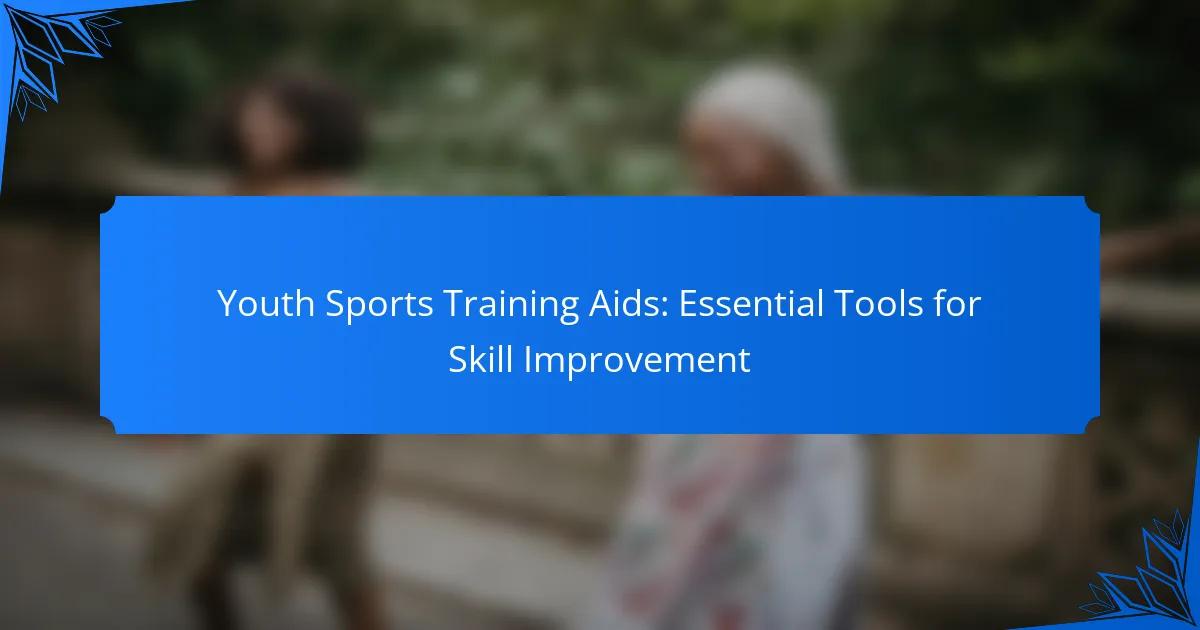Youth sports training aids are vital tools that enhance skill improvement by focusing on agility, strength, and coordination. Designed to make practice enjoyable, these aids help young athletes develop essential physical attributes necessary for success in various sports. With a variety of high-quality options available, these tools not only boost performance but also ensure safety during training sessions.

What are the best youth sports training aids for skill improvement?
The best youth sports training aids for skill improvement include tools that enhance agility, strength, and coordination. These aids are designed to facilitate practice and help young athletes develop essential skills in a fun and engaging way.
Agility ladders
Agility ladders are excellent for improving foot speed, coordination, and overall agility. They consist of a series of rungs connected by straps, laid flat on the ground. Athletes can perform various drills, such as high knees or lateral shuffles, to enhance their quickness and balance.
When using agility ladders, focus on maintaining proper form and speed. Start with basic patterns and gradually increase complexity as confidence builds. A common mistake is rushing through drills without focusing on technique, which can lead to injuries.
Resistance bands
Resistance bands are versatile tools that help build strength and flexibility. They come in various resistance levels, making them suitable for different age groups and skill levels. Bands can be used for exercises targeting specific muscle groups, enhancing overall athletic performance.
Incorporate resistance bands into warm-ups or strength training routines. Ensure proper attachment points to avoid accidents, and encourage athletes to maintain controlled movements. Avoid overstretching the bands, as this can lead to snapping and potential injury.
Weighted vests
Weighted vests are designed to add extra resistance during training, helping to improve strength and endurance. Wearing a vest while performing drills can enhance muscle engagement and increase workout intensity. They are particularly useful for sports that require explosive movements, such as basketball or soccer.
When using weighted vests, start with light weights and gradually increase as athletes become accustomed to the added resistance. Ensure the vest fits properly to avoid discomfort or distraction during training. Avoid using excessive weight that could hinder movement or lead to injury.
Dribbling cones
Dribbling cones are essential for developing ball control and spatial awareness in sports like soccer and basketball. These cones can be set up in various formations to create dribbling courses that challenge athletes to maneuver around obstacles while maintaining control of the ball.
Set up drills that focus on different skills, such as speed dribbling or change of direction. Encourage athletes to keep their heads up while dribbling to improve awareness of their surroundings. A common pitfall is placing cones too close together, which can lead to frustration and hinder skill development.
Speed hurdles
Speed hurdles are used to improve stride length and frequency, making them ideal for sprint training. These lightweight hurdles can be adjusted in height, allowing athletes to practice various drills that enhance their speed and agility.
Incorporate speed hurdles into sprint workouts, focusing on quick foot placement and proper form. Start with lower hurdles to build confidence before progressing to higher ones. Avoid using hurdles that are too high for the athlete’s current skill level, as this can lead to falls and injuries.

How do youth sports training aids enhance performance?
Youth sports training aids enhance performance by providing targeted practice tools that improve specific athletic skills. These aids help young athletes develop essential physical attributes such as agility, strength, and coordination, which are crucial for success in various sports.
Improved agility
Agility training aids, such as agility ladders and cones, are designed to enhance quickness and footwork. By incorporating these tools into practice routines, young athletes can develop faster reaction times and better movement patterns, which are vital in sports requiring rapid changes in direction.
To effectively use agility aids, athletes should focus on drills that emphasize speed and precision. For example, performing ladder drills for short durations, like 10-15 seconds, can significantly improve foot speed. Consistency in training is key; aim for 2-3 sessions per week to see noticeable improvements.
Increased strength
Strength training aids, including resistance bands and weighted vests, help youth athletes build muscle power and endurance. These tools allow for safe and effective strength training tailored to the developmental needs of younger athletes.
When using strength training aids, it’s important to start with lighter resistance and gradually increase as strength improves. Exercises like squats or push-ups with resistance bands can be effective. Aim for 2-3 sets of 8-12 repetitions, ensuring proper form to prevent injury.
Better coordination
Coordination training aids, such as balance boards and reaction balls, enhance hand-eye and foot-eye coordination. These tools are particularly beneficial for sports that require precise movements, such as basketball or soccer.
Incorporating coordination drills into practice can be simple and fun. For instance, using a reaction ball to improve reflexes can be done in short bursts of 5-10 minutes. Regular practice, ideally 2-3 times a week, can lead to significant improvements in overall athletic performance.

What are the top brands for youth sports training aids?
Several brands stand out for their quality and effectiveness in youth sports training aids. These brands offer a variety of tools designed to enhance skill development, improve performance, and ensure safety during training sessions.
SKLZ
SKLZ is renowned for its innovative training aids that cater to various sports, including soccer, basketball, and baseball. Their products, such as agility ladders and resistance bands, focus on improving speed, agility, and strength.
When selecting SKLZ products, consider the specific skills you want to develop. For example, their agility cones are excellent for enhancing footwork and coordination, making them ideal for young athletes looking to improve their game.
ProForm
ProForm specializes in fitness equipment that can also benefit young athletes. Their training aids, like balance boards and stability balls, help build core strength and stability, essential for all sports.
For youth training, ProForm’s equipment is user-friendly and often adjustable, making it suitable for various skill levels. Incorporating these tools into workouts can lead to improved overall athletic performance.
TRX
TRX is well-known for its suspension training systems that utilize body weight for resistance. This brand offers versatile training aids that can be used for strength, flexibility, and balance training.
Using TRX for youth training can be highly effective, as it allows for a wide range of exercises that can be tailored to individual fitness levels. It’s important to ensure proper form to prevent injuries, especially for younger athletes.
Champion Sports
Champion Sports provides a comprehensive range of training aids for various sports, including basketball, soccer, and track and field. Their products, such as training balls and practice equipment, are designed to enhance skill development.
When choosing Champion Sports products, look for items that align with specific training goals. Their durable equipment is often budget-friendly, making it accessible for schools and youth sports programs.

What factors should be considered when choosing training aids?
Choosing the right training aids for youth sports involves evaluating several key factors to ensure they enhance skill development effectively. Considerations include the age of the athletes, the specific sport being practiced, and the durability of the equipment to withstand regular use.
Age appropriateness
Age appropriateness is crucial when selecting training aids, as tools designed for older athletes may not suit younger ones. For instance, a lightweight bat or a smaller ball can help younger players develop their skills without the risk of injury. Always check manufacturer recommendations for age ranges to ensure safety and effectiveness.
Additionally, consider the developmental stage of the child. Training aids that promote fundamental skills, such as coordination and balance, are beneficial for younger age groups, while more advanced tools can be introduced as athletes mature.
Sport specificity
Sport specificity refers to how well a training aid aligns with the skills required for a particular sport. For example, soccer training aids like agility ladders or dribbling cones focus on footwork and ball control, while basketball may require shooting aids or rebounders. Selecting tools that directly enhance the skills needed for the sport will yield better results.
When evaluating sport-specific training aids, consider the common skills that need improvement and choose equipment that targets those areas. This ensures that practice sessions are both relevant and productive.
Durability
Durability is a key factor in choosing training aids, especially for youth sports where equipment may face rough handling. Look for materials that can withstand frequent use, such as high-quality plastics or reinforced fabrics. Investing in durable aids can save money in the long run by reducing the need for replacements.
It’s also wise to read reviews or seek recommendations from coaches and other parents regarding the longevity of specific training aids. A well-made product can provide consistent support for skill development over multiple seasons.



